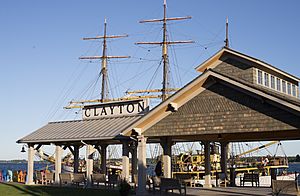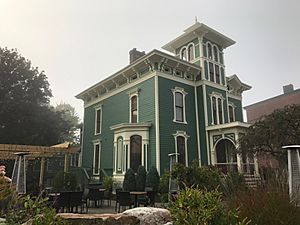Clayton, New York facts for kids
Quick facts for kids
Clayton, New York
|
|
|---|---|

The Clayton harbor in Frink Park (with the Picton Castle tall ship in the background).
|
|
| Country | United States |
| State | New York |
| County | Jefferson |
| Area | |
| • Total | 104.25 sq mi (269.99 km2) |
| • Land | 82.54 sq mi (213.78 km2) |
| • Water | 21.70 sq mi (56.21 km2) |
| Population
(2010)
|
|
| • Total | 5,153 |
| • Estimate
(2016)
|
4,928 |
| • Density | 59.70/sq mi (23.05/km2) |
| Time zone | UTC-5 (EST) |
| • Summer (DST) | UTC-4 (EDT) |
| ZIP code |
13624
|
| Area code(s) | 315 |
| FIPS code | 36-045-16100 |
Clayton is a town in Jefferson County, New York, United States. In 2010, about 5,153 people lived here. The town is named after John M. Clayton, an important political leader from Delaware.
The town of Clayton also contains a village that shares the same name, Clayton. Both are located northwest of the city of Watertown.
The village of Clayton, along with nearby Cape Vincent and Alexandria Bay, are popular places for tourists. They are all found in the Thousand Islands region of New York.
Contents
History of Clayton
The first settlers arrived in the Clayton area around the year 1801.
How Clayton Was Formed
The town of Clayton was officially created in 1833. It was formed from parts of two other towns: Orleans and Lyme. The town got its name from a famous statesman, John M. Clayton.
Clayton's Role in Tourism
During the late 1800s and early 1900s, the village of Clayton became a major hub for the Thousand Islands resort area. It was the main train station for visitors coming to enjoy the beautiful region. Many grand hotels were built in Clayton to welcome these tourists, though most of them are gone today.
In 1872, the community of Clayton decided to become its own separate village. This meant it would have its own local government.
Historic Places in Clayton
Several important places in Clayton are listed on the National Register of Historic Places. These include Fairview Manor, the Swarthout Site-A04507.000038, and the Grindstone Island Upper Schoolhouse. These sites are recognized for their historical importance.
Geography of Clayton
Clayton covers a total area of about 104 square miles (269 square kilometers). Most of this area, about 82.5 square miles (213.3 square kilometers), is land. The rest, about 21.7 square miles (56.1 square kilometers), is water.
Location and Waterways
The town is located right on the St. Lawrence River, which flows into Lake Ontario. Across the river, you can see the country of Ontario, Canada.
The northern edge of Clayton is the Canada–United States border. This border runs right through the Thousand Islands in the St. Lawrence River.
Islands in Clayton
Clayton includes many islands that are part of the Thousand Islands. The fourth largest of these is Grindstone Island. Other smaller islands in the town include Bluff Island, Grenell Island, Maple Island, Picton Island, and Round Island.
Transportation and Roads
A ferry used to connect Clayton to Gananoque in Ontario, Canada. However, this ferry service stopped when the Thousand Islands Bridge was built. This bridge is about 10 miles (16 kilometers) northeast of Clayton. Today, the bridge carries traffic from Interstate 81 directly into Canada.
Important roads in Clayton include New York State Route 12E, which runs along the St. Lawrence River. It meets New York State Route 12 in Clayton village. New York State Route 180 also passes through the southeastern part of the town.
Population of Clayton
The population of Clayton has changed over the years. Here's how many people have lived in the town during different census years:
| Historical population | |||
|---|---|---|---|
| Census | Pop. | %± | |
| 1840 | 3,990 | — | |
| 1850 | 4,191 | 5.0% | |
| 1860 | 4,696 | 12.0% | |
| 1870 | 4,082 | −13.1% | |
| 1880 | 4,214 | 3.2% | |
| 1890 | 4,411 | 4.7% | |
| 1900 | 4,313 | −2.2% | |
| 1910 | 4,028 | −6.6% | |
| 1920 | 3,618 | −10.2% | |
| 1930 | 3,698 | 2.2% | |
| 1940 | 3,768 | 1.9% | |
| 1950 | 3,758 | −0.3% | |
| 1960 | 3,753 | −0.1% | |
| 1970 | 4,021 | 7.1% | |
| 1980 | 4,028 | 0.2% | |
| 1990 | 4,629 | 14.9% | |
| 2000 | 4,817 | 4.1% | |
| 2010 | 5,153 | 7.0% | |
| 2016 (est.) | 4,928 | −4.4% | |
| U.S. Decennial Census | |||
In 2000, there were about 4,817 people living in the town of Clayton. There were 1,914 households, and 1,335 families. The population density was about 58 people per square mile (23 people per square kilometer).
About 34.5% of households had children under 18 living with them. The average household had 2.51 people, and the average family had 3.00 people.
The age breakdown in 2000 showed that 26.7% of the population was under 18 years old. About 15.1% were 65 years or older. The average age in Clayton was 38 years.
Communities and Features
Clayton is home to several smaller communities and interesting natural features:
- Aunt Janes Bay – A bay located on the south side of Grindstone Island.
- Bartlett's Point – A small community west of Clayton village. It sits on a land feature called Bartlett Point.
- Blind Bay – A small bay on the St. Lawrence River, near the eastern border of the town.
- Chaumont River – A river that flows through the southern part of Clayton. It eventually joins Chaumont Bay in Lake Ontario.
- Clayton (village) – The main village in the town, located on the shore of the St. Lawrence River.
- Clayton Center – A small community found on County Road 10 in the eastern part of the town.
- Depauville – A community on NY-12, south of Clayton village. It is located by the Chaumont River.
- Delaney Bay – A bay on the eastern side of Grindstone Island.
- Flynn Bay – A bay located at the southwestern part of Grindstone Island.
- French Creek – A smaller river that flows into the St. Lawrence River at French Creek Bay.
- French Creek Bay – A bay on the western side of Clayton village.
- French Creek Wildlife Management Area – A special area set aside to protect wildlife in northern Clayton.
- Frontenac – A community on the northeastern end of Round Island.
- Frontenac Springs – A place in the northwestern part of Clayton known for its natural spring water.
- Grenell Island – An island in the St. Lawrence River near the eastern town line.
- Grenell – A community located on Grenell Island.
- Grindstone – A community on the northern side of Grindstone Island.
- Grindstone Island – The fourth largest of the Thousand Islands. It is across from Clayton village in the St. Lawrence River.
- Gunns Corners – A community in the southeastern part of the town, where NY-180 meets NY-12.
- Murray Isle – An island in the St. Lawrence River near the eastern town line.
- Reynolds Corners – A location at the southern town line on County Road 125.
- Round Island – An island in the St. Lawrence River northeast of Clayton, known for its many summer homes. Little Round Island is right next to it.
- Schnauber Hill – A raised area of land near the eastern town line.
- Smith Corners – A location on NY-12 between Depauville and Clayton village.
- Washington Island – A small island located next to Clayton village.
Parks in Clayton
Clayton has several parks where you can enjoy nature:
- Canoe-Picnic Point State Park – This state park is on Grindstone Island and can only be reached by boat.
- Cedar Point State Park – Another state park located near the western border of the town.
Fun Things to Do
There are many fun activities and places to visit in Clayton:
- Antique Boat Museum – Learn about old boats and their history.
- Rock Island Lighthouse – Visit this historic lighthouse.
- Frink Park – A nice park to relax and enjoy the views.
- Clayton Island Tours – Take a boat tour to explore the Thousand Islands.
Places to Visit
- Clayton Chamber of Commerce – Find more information about visiting Clayton.
Famous People from Clayton
Some notable people have connections to Clayton:
- Charles E. Bohlen – A diplomat who served as an ambassador.
- Albert Bouchard and Joe Bouchard – Founding members of the band Blue Öyster Cult.
- Mary Fowkes – A physician and neuropathologist.
- Abbie Hoffman – A political and social activist. He founded the "Save the River" group while using the name 'Barry Freed'.
- May Irwin – A famous singer and vaudeville star who spent her summers and later retired here.
- Bill Johnston – A well-known smuggler and river pirate from the Thousand Islands.
- Joseph Lonsway – A soldier in the Union Army who received the Congressional Medal of Honor.
- Nancy Fowler McCormick – A person known for her charitable giving.
See also
 In Spanish: Clayton (Nueva York) para niños
In Spanish: Clayton (Nueva York) para niños





